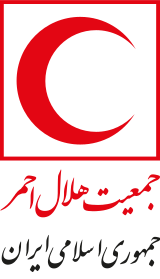 | |
| Abbreviation | IRCS |
|---|---|
| Formation | 1922 |
| Founder | Amir Amir-Aʿlam[1] |
| Type | NGO |
| Legal status | Legislated by the Iranian Parliament on 28 April 1988[1] |
| Purpose | Humanitarian aid |
| Headquarters | Building of Peace, 136 Pahlavi St., Tehran |
Region served | Iran |
| Services |
|
| Fields |
|
Secretary General | Dr. Yaghob Soleymani |
President | Pir-Hossein Kolivand[2] |
Budget (2016–17) | $231.36 million[3] |
Staff (2005) | 7,000 paid employees[4] |
Volunteers (2017) | 2,000,000[5] |
| Website | en |
Formerly called | Red Lion and Sun Society |
The Iranian Red Crescent Society (IRCS), officially the Red Crescent Society of the Islamic Republic of Iran (Persian: جمعیت هلال احمر جمهوری اسلامی ایران, romanized: Jamʿiyyat-e Helâl-e Ahmar-e Jomhuri-ye Eslâmi-ye Irân) is a non-governmental humanitarian organization in Iran.[1] Founded as the Red Lion and Sun Society in 1922,[4] it became affiliated with the International Federation of Red Cross and Red Crescent Societies (IFRC) in 1924[6] and changed its name and emblem in 1980, informing the international community of Hilal Ahmar adoption[7] while assuming the right to adopt the former emblem in future.[1]
The society is one of the world's largest national societies within IFRC[4] and is noted for its special expertise in responding to earthquakes.[8]
Since inception, the IRCS has participated in a variety of public activities. Its core activity is to perform relief and rescue operations to help victims and the injured in natural disasters and accidents. It also engages a in wide range of humanitarian services in health and rehabilitation, training and research.[4] The society had a therapeutic approach and was regarded a major healthcare institution with thousands of hospital beds across the country until 1979, when all of its medical facilities were transferred to the Ministry of Health.[1]
IRCS is an example of strong national societies that play an important role domestically[8] and is held in high esteem by the Iranian general public.[4]
- ^ a b c d e Ghassemlou, Farid (21 January 2016). "JAMʿIYAT-E HELĀL-E AḤMAR-E IRĀN". Encyclopædia Iranica (Online ed.). New York City: Bibliotheca Persica Press.
- ^ "UN Humanitarian head praised Iran for rescue attempts after quake", Islamic Republic News Agency, 23 November 2017, 82740384, retrieved 24 November 2017
- ^ "IRCS Slams Meager Budget Increase", Financial Tribune, 19 December 2016, 82632949, retrieved 24 November 2017,
The government has increased IRCS budget for renovation and procurement of relief supplies by 1,000 billion rials ($25.64 million at market exchange rate) to 5,000 billion rials ($128.2 million). IRCS's budget for relief supplies saw a steep cut of 3,000 billion rials ($76.92 million) last year to stand at 7,000 billion rials ($179.48 million). It was again reduced to 4,000 billion rials ($102.56 million) in the current Iranian year's budget, the Persian daily Shahrvand reported.
- ^ a b c d e Toni Pfanner; Andreas Wigger; Mostafa Mohaghegh (June 2005), "Interview with Ahmad Ali Noorbala", International Review of the Red Cross, 87 (858), International Committee of the Red Cross: 241–253 – via Cambridge University Press
- ^ "Red Crescent volunteer organization with 2mn members", Islamic Republic News Agency, 15 August 2017, 82632949, retrieved 24 November 2017
- ^ "IRCS among top five int'l relief bodies", Iran daily, 4 January 2015, 58883, retrieved 24 November 2017
- ^ H. Beer; J. Moreillon (December 1980), "Adoption of the red crescent by the Islamic Republic of Iran", International Review of the Red Cross, 20 (219), International Committee of the Red Cross: 316–317, doi:10.1017/S002086040006736X – via Cambridge University Press
- ^ a b Jonathan Benthall (subscription required) (1997). "The Red Cross and Red Crescent Movement and Islamic Societies, with Special Reference to Jordan". British Journal of Middle Eastern Studies. 24 (2). British Society for Middle Eastern Studies: 157–177. doi:10.1080/13530199708705644. JSTOR 195770.
{{cite journal}}: CS1 maint: multiple names: authors list (link) CS1 maint: numeric names: authors list (link)